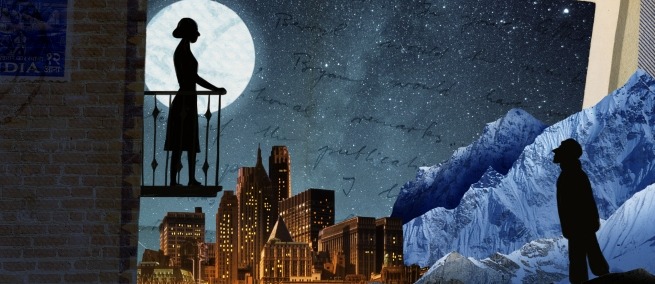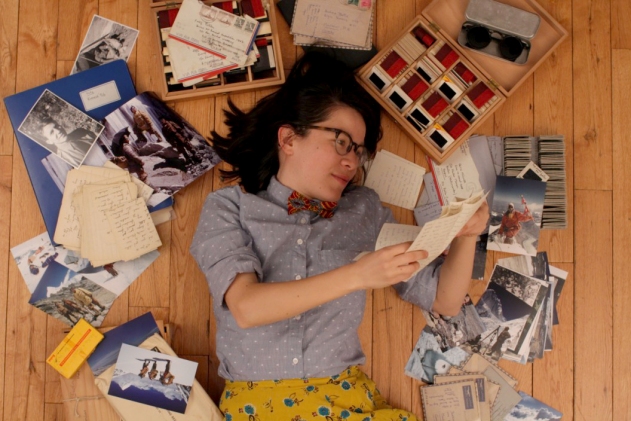
LOVE LETTERS FROM EVEREST, a new animated and live action short film, depicts the love story of writer/director Celeste Koon’s grandparents: Barbara Battle and Fritz Müller. On the occassion of Valentine's Day, the short is available to stream below.
The story begins when Barbara was living in Canada and was introduced to Fritz, a young Ph.D. student in glaciology at McGill who needed help with his English. Barbara offered to help him, and the two fell in love. Soon thereafter, Fritz was enlisted into the 1956 Swiss Everest expedition, set to be the second group to summit Everest and the first to summit Lhotse, a subpeak in the Everest range. Fritz agreed to the adventure, as he was a glaciologist and would use the experience to explore the glacial terrain of the mountains. Throughout the year-long trek. Fritz and Barbara exchanged letters, which act as the narrative structure of LOVE LETTERS FROM EVEREST.

Still from the film, courtesy of the filmmakers
The 1956 Swiss Everest Expedition was conceived and funded by The Swiss Foundation for Alpine Research. Originally planned for 1954, the expedition was pushed two years because The Daily Mail was trekking in the same area searching for the Yeti. At this point in time, the only people to ever complete the 29,000 climb up Everest were New Zealander Edmund Hillary and Sherpa Tenzing Norgay in 1953, so this expedition was to be the second group to reach the mountain’s peak and the first to summit Lhotse. The team was led by Albert Eggler and Wolfgang Diehl.
On March 2, in a town called Jayanagar which lies on the border of India and Nepal, the team convereged with 22 sherpas from Darjeeling, and together began to ascend the glacial terrain of Everest. At this point in the climb, the weather was suprisinnly temperate: In Eggler’s writings published later by the Swiss Foundation for Alpine Research, he describes the vegetation: “sometimes we passed through woods full of red rhododendron blossom and then traversed the rice, maize, barley and potato fields built by the natives in terraces across the mountain slopes.”
By April 11th, Camp I, over 15,000 feet above sea level, was established as the first permanent camp for the expedition. Once the team climbed thousands of feet higher, they established Camp III and Fritz set up a meteorological station and laboratory for his research on Everest's Khumbu Glacier. At this station, he documented the status of glacial ice and geography in the region via photography. These documents are used in modern day investigations on the impact of climate change–they serve as visual metrics of how the conditions have changed in the area.
While Fritz was documenting the terrain, his colleagues were scouting, clearing, and planning the best path forward. Eggler described in his writings that there was always plenty of work to do on the glacier, and “the constant movement in the icefall, and the grumblings and mutterings which reached us from the depths” were like a higher power. Crevasses widened significantly each day, so the climbers constructed bridges with ladders they’d brought from Switzerland and used ten-foot wooden poles that they’d collected from past group’s abandoned camps. Additionally, the team put thousands of feet of ropes into place, and cut steps into the ice itself. The innovation put into these designs paid off and eventually, the group moved on to Camp IV, at 23,000 feet, Camp V at 24,500 feet, and finally, to Camp VI at 26,000 feet.
.jpg)
Still from the film, courtesy of the filmmakers
By the time the group reached Camp VI on May 9th, they were eager to reach the top of Lhotse, and they were extremely close; however, weeks of brutal weather prevented them from progressing further. Fritz and most of the team retreated to Camp III. Two climbers, Ernst Reiss and Fritz Luchsinger, kept on and on May 18 summited Lhotse’s peak–the first humans to ever do so. On May 23, the entire team scaled the peak of the most daunting mountain in the world: Everst.
During this entire, grueling climb, Fritz took time to write to Barbara, as LOVE LETTERS FROM EVEREST chronicles. The film was written and directed by Celeste Koon, Fritz and Barabara’s granddaughter, produced by Shasha Nakhai, animated by Anna Bron and stop motion animator Evan DeRushie, and edited by Rich Williamson. It is available to watch below.
The information about the 1956 Swiss Everest expedition was obtained from writings by Eggler and the Swiss Foundation for Alpine Research.
TOPICS